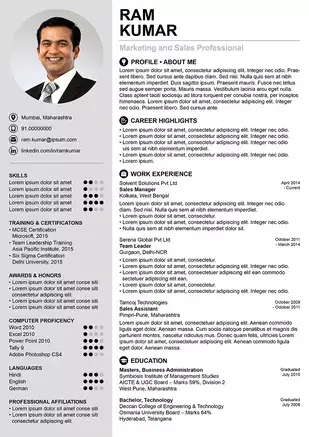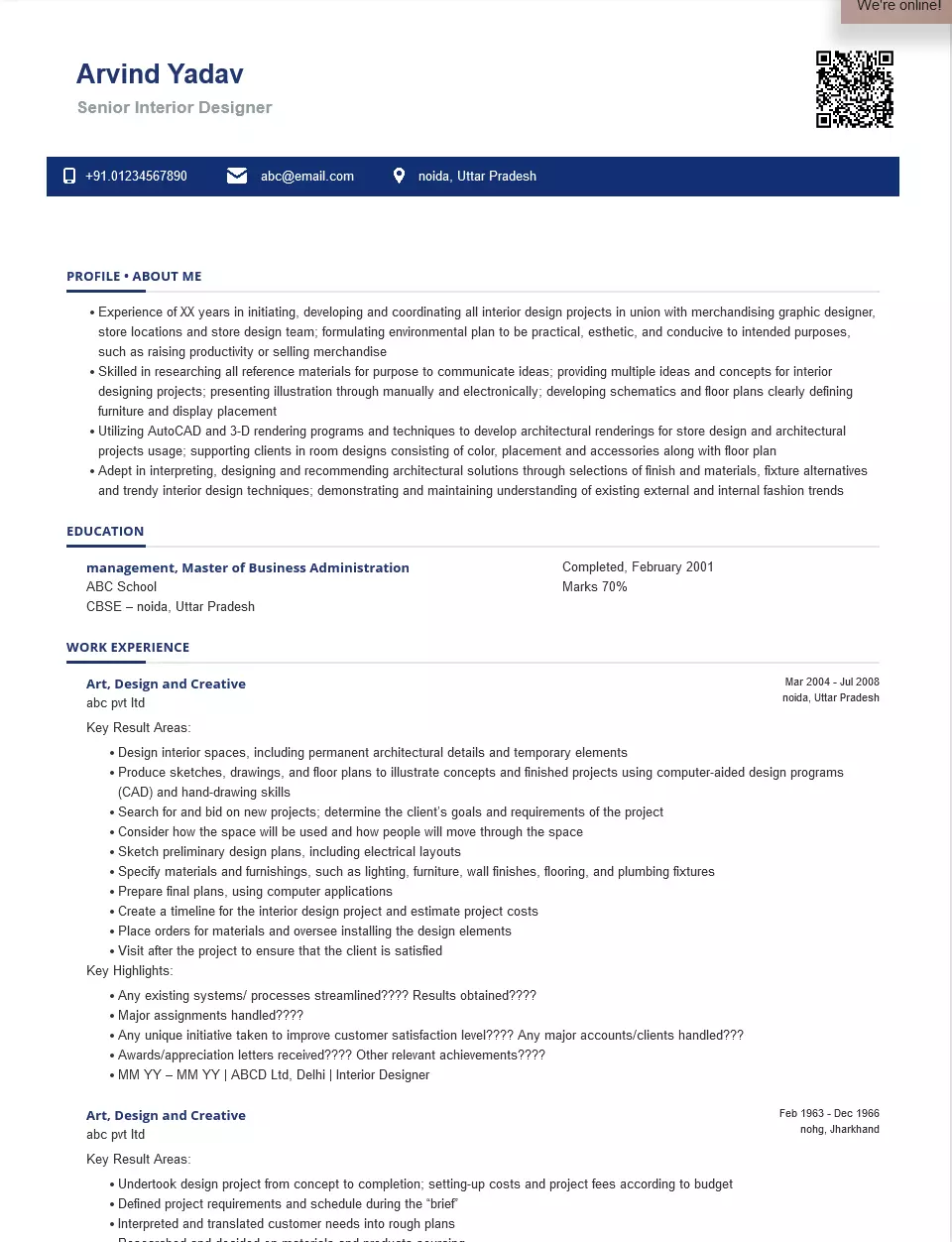- Certificate in Computer-Aided Interior Design, Completed , January 2005
What's your job?
Interior Designer Resume Samples and Templates for 2026
- Table of Contents
- Downloadable Sample
- Resume Tips from Experts
- Resume Text Version
- Share
Interior Designer Resume Guide for India
A well-crafted interior designer resume is essential for success in India’s booming real estate and interior design industry. Whether you’re a fresher starting your career after completing a design degree from CEPT or NID, or an experienced professional seeking growth at top firms like Livspace, Studio Lotus, or Godrej Interio, this guide provides everything you need to create a standout resume that impresses Indian employers and passes ATS screening on portals like Naukri and LinkedIn.
This comprehensive guide includes:
- Resume format recommendations for India
- Key skills Indian employers look for
- Complete resume example with Indian context
- Top interior designer employers in India
- Salary insights in INR by experience level
- Portfolio and certification guidance
- ATS optimization tips for Indian job portals
Why Your Interior Designer Resume Matters in India
India’s interior design industry is valued at over ₹20,000 crore, with companies like Livspace, HomeLane, Design Cafe, Godrej Interio, and Asian Paints Beautiful Homes actively hiring talented interior designers. A strong resume helps you:
- Stand out from thousands of applicants on Naukri and LinkedIn
- Pass ATS screening used by major Indian design firms and corporates
- Showcase skills that Indian hiring managers value, including space planning and Vastu considerations
- Demonstrate your understanding of Indian design aesthetics and client preferences
Indian recruiters typically spend 6-10 seconds reviewing each resume initially. Your interior designer resume must immediately communicate your design sensibility, technical skills, and portfolio highlights. With the growing demand for professional interior design in India’s expanding urban landscape, a well-optimized resume is your ticket to landing interviews at top firms.
Interior Designer Resume Format for India
Indian employers prefer clean, professional resume formats that showcase creativity while remaining readable. Here’s what works best:
Recommended Format
- Length: 1-2 pages (freshers: 1 page, experienced: 2 pages max)
- Layout: Reverse chronological (most recent first)
- Font: Clean, elegant fonts like Garamond, Helvetica, or Lato (11-12pt)
- Sections: Contact, Summary, Portfolio Link, Skills, Experience, Education, Certifications
Resume vs Portfolio
In India, your resume and portfolio work together. Your resume should be clean and professional, while your portfolio showcases your design projects. Include a prominent link to your Behance, Houzz, or personal website.
Personal Details for Indian Interior Designer Resumes
Indian resumes typically include:
- Full name and professional photo (optional for private sector)
- Phone number with country code (+91)
- Professional email address
- LinkedIn profile URL
- Portfolio link (Behance/Houzz/Personal website)
- City, State (full address not required)
What to Avoid
- Overly decorative designs (causes ATS issues)
- Personal information like religion, caste, or father’s name (outdated practice)
- Salary expectations (discuss during interview)
- References (provide when requested)
Key Skills for Interior Designers in India
Indian employers look for a combination of technical design expertise and soft skills relevant to the Indian market.
Technical Skills
- AutoCAD: Essential for technical drawings and floor plans
- SketchUp: 3D modeling and visualization
- 3ds Max/V-Ray: Photorealistic rendering for client presentations
- Revit: BIM software for larger projects
- Space Planning: Optimizing layouts for Indian homes and offices
- Material Knowledge: Understanding of Indian materials, vendors, and finishes
- Vastu Shastra: Understanding of traditional Indian architectural principles
Software & Tools
- AutoCAD
- SketchUp Pro
- 3ds Max with V-Ray
- Revit
- Adobe Photoshop
- Adobe Illustrator
- Enscape
- Lumion
Soft Skills Valued in Indian Workplaces
- Communication: Clear English and Hindi for client interactions
- Client Management: Understanding diverse Indian client preferences
- Teamwork: Collaborating with contractors, vendors, and architects
- Budget Management: Working within Indian budget constraints
- Problem-Solving: Creative solutions for space and structural challenges
How to Present Skills
List skills in order of relevance to the job description. Use exact keywords from job postings on Naukri or LinkedIn to improve ATS matching. For interior design roles, prioritize AutoCAD, SketchUp, and space planning expertise.
Interior Designer Resume Example for India
Here’s a complete resume example tailored for Indian employers:
Ananya Sharma
Mumbai, Maharashtra | +91-98XXX-XXXXX | ananya.sharma@email.com | linkedin.com/in/ananyasharma | behance.net/ananyainteriors
Professional Summary
Creative Interior Designer with 6+ years of experience in residential and commercial design projects across Mumbai and Pune. Proven track record of delivering elegant, functional spaces that blend contemporary aesthetics with Indian sensibilities. Expertise in AutoCAD, SketchUp, 3ds Max, and project execution with a portfolio of 50+ completed projects worth ₹15 Cr+.
Key Skills
AutoCAD | SketchUp Pro | 3ds Max V-Ray | Space Planning | Material Selection | Vastu Principles | Client Management | Vendor Coordination | Budget Planning | Project Execution
Professional Experience
Senior Interior Designer | Livspace | Mumbai | March 2022 – Present
- Lead design for 30+ residential projects worth ₹8 Cr+, achieving 98% client satisfaction
- Manage end-to-end project execution from concept to handover with average 15% under budget delivery
- Mentor team of 4 junior designers, conducting weekly design reviews and skill-building sessions
- Developed modular design templates reducing project turnaround time by 25%
- Coordinate with vendors, contractors, and craftsmen for seamless execution
Interior Designer | Design Cafe | Bangalore | June 2019 – February 2022
- Designed 40+ residential interiors for apartments ranging from 1BHK to 4BHK
- Created 3D visualizations and presentations converting 80% of client consultations
- Specialized in kitchen and wardrobe design with modular solutions
- Managed material procurement and vendor relationships for cost optimization
Junior Interior Designer | Studio Format | Pune | July 2017 – May 2019
- Assisted senior designers on commercial and residential projects
- Created detailed AutoCAD drawings, material schedules, and BOQs
- Conducted site visits and supervised installation work
- Developed 3D models and rendered presentations for client approvals
Education
Bachelor of Design (B.Des) | CEPT University, Ahmedabad | 2017
- Specialization: Interior Design
- Relevant Coursework: Space Planning, Furniture Design, Lighting Design, Building Materials
Higher Secondary (12th) | DPS, Pune | 2013
- Arts with Fine Arts
Certifications
- Autodesk AutoCAD Professional | Autodesk | 2023
- V-Ray Certified Professional | Chaos Group | 2022
- Interior Design Excellence Award | IIID | 2021
Portfolio
View my complete portfolio at: behance.net/ananyainteriors
Featured projects include:
- 4BHK Luxury Apartment, Worli (Livspace)
- Boutique Office Design, Bandra
- Heritage Home Renovation, Pune
Declaration
I hereby declare that the information provided above is true to the best of my knowledge.
Ananya Sharma Mumbai, December 2024
Note: Declaration statements are common in Indian resumes, especially for traditional companies.
Top Interior Designer Employers in India
India’s interior design industry offers excellent opportunities. Here are the top employers:
Tech-Enabled Design Firms
- Livspace: India’s largest home interiors platform with pan-India presence
- HomeLane: Technology-driven interior solutions
- Design Cafe: Experience centers across major cities
- Homelane: Modular interior solutions
- UrbanClap/Urban Company: Design services platform
Established Design Studios
- Studio Lotus: Award-winning architecture and interior firm
- Morphogenesis: Sustainable design focus
- Rajiv Saini & Associates: Premium residential design
- Sanjay Puri Architects: Innovative commercial interiors
- Abraham John Architects: Hospitality and luxury design
Corporate & Furniture Companies
- Godrej Interio: Furniture and interior solutions
- Asian Paints Beautiful Homes: Interior design services
- IKEA India: Retail interior design
- Nilkamal: Commercial and residential solutions
- Featherlite: Office interiors
Real Estate Developers
- Lodha Group: In-house design teams
- Godrej Properties: Interior design for model apartments
- Sobha Limited: Premium project interiors
- DLF: Commercial and residential design
- Prestige Group: South India presence
How to Apply
- Visit company career pages directly
- Apply through Naukri.com and LinkedIn
- Build a strong Behance/Houzz presence
- Network at events like India Design ID
- Register with IIID for industry connections
Interior Designer Salary in India
Salaries vary based on experience, location, company type, and specialization.
Salary by Experience Level
| Experience | Annual Salary (INR) |
|---|---|
| Fresher (0-1 years) | ₹2.5 - ₹4.5 LPA |
| Early Career (2-4 years) | ₹4.5 - ₹8 LPA |
| Mid-Career (5-8 years) | ₹8 - ₹15 LPA |
| Senior (8+ years) | ₹15 - ₹30+ LPA |
Note: Tech-enabled firms like Livspace typically pay higher base salaries; boutique studios may offer project incentives.
Salary by City
| City | Salary Range (Mid-Level) |
|---|---|
| Mumbai | ₹8 - ₹15 LPA |
| Bangalore | ₹7 - ₹13 LPA |
| Delhi NCR | ₹6 - ₹12 LPA |
| Hyderabad | ₹5 - ₹10 LPA |
| Pune | ₹5 - ₹10 LPA |
| Chennai | ₹5 - ₹9 LPA |
Factors Affecting Salary
- Specialization: Hospitality and luxury residential designers command higher salaries
- Company type: Tech-enabled firms and MNCs typically pay more
- Portfolio strength: High-value projects boost earning potential
- Location: Metro cities offer significantly higher salaries
Salary data based on Glassdoor India, AmbitionBox, and industry surveys.
Certifications for Interior Designers in India
Professional certifications boost your credibility and demonstrate expertise.
Valuable Certifications
- Autodesk Certified Professional: AutoCAD and Revit certifications
- V-Ray Certified Professional: Rendering expertise
- LEED Certification: Green building design
- GRIHA: Indian green building certification
Design Education in India
- CEPT University: Premier architecture and design school
- NID (National Institute of Design): Furniture and interior design
- SPA Delhi: Architecture and planning
- JJ School of Art: Fine arts and design
- Rachana Sansad: Interior design focus
Professional Bodies
- IIID (Institute of Indian Interior Designers): Professional membership
- IIA (Indian Institute of Architects): For dual architect-designers
- CIDA (Council for Interior Design Accreditation): International recognition
How to List Certifications
Include certification name, issuing organization, and year obtained. Professional body memberships add credibility. Focus on certifications that complement your specialization.
ATS Tips for Your Interior Designer Resume
Most Indian companies use Applicant Tracking Systems (ATS) to screen resumes. Optimize yours for better results:
For Naukri.com
- Use keywords from the job description (AutoCAD, space planning, 3ds Max)
- Keep formatting simple—ATS can’t read complex layouts
- Use standard section headings (Experience, Education, Skills)
- Upload in .docx or .pdf format
- Include portfolio link prominently
For LinkedIn Applications
- Match your resume to your LinkedIn profile for consistency
- Use industry-standard job titles (Interior Designer, not “Space Transformer”)
- Include relevant keywords in your skills section
- Get endorsements for key skills from colleagues
General ATS Tips
- DO: Use clean fonts, clear headings, bullet points
- DO: Include exact keywords from job postings (AutoCAD, residential design, space planning)
- DO: Save a separate ATS-friendly version of your resume
- DON’T: Use headers/footers, text boxes, or complex graphics
- DON’T: Use creative section titles (use “Experience” not “My Design Journey”)
Keyword Strategy for Indian Interior Design Roles
Review 5-10 job postings for interior designer positions on Naukri. Common keywords include:
- AutoCAD, SketchUp, 3ds Max
- Space planning, furniture layout
- Residential design, commercial interiors
- Material selection, vendor coordination
- Project management, client handling
Final Tips for Your Interior Designer Resume
✅ Portfolio first: Your portfolio matters more than your resume—showcase 8-12 best projects with before/after images
✅ Quantify projects: Include project values, area covered (sq ft), and client satisfaction metrics
✅ Show versatility: Demonstrate skills across residential, commercial, and specialized projects
✅ Include Indian context: Show understanding of Vastu, local materials, and Indian aesthetic preferences
✅ Keep it clean: Your resume should be professional; save creativity for your portfolio
✅ Update regularly: Refresh your portfolio and resume every 3-6 months
Quick Checklist
- Contact information complete with +91 phone number and LinkedIn
- Portfolio link prominently displayed (Behance/Houzz/Personal site)
- Professional summary highlights specialization and project value
- Skills section includes software proficiency and design expertise
- Experience shows quantified achievements and notable projects
- Education includes design institute and relevant coursework
- Certifications and IIID membership listed
- Formatting is clean and ATS-friendly
- Length is appropriate (1-2 pages)
Ready to create your professional interior designer resume? Use our resume builder to get started with expert-designed templates optimized for Indian job portals and ATS systems.
Looking for more guidance? Check out our resume format guide for additional tips on structuring your design resume for the Indian job market.
Interior Designer Text-Only Resume Templates and Samples
Arvind Yadav
Phone: 01234567890
Email: abc@email.com
Address: Sec-44, Noida, Noida
About Me
Senior Interior Designer / Interior Designer
- Innovative and experience of XX years in initiating, developing, and coordinating all interior design projects in union with merchandising graphic designer, store locations, and store design team; formulating an environmental plan to be practical, esthetic, and conducive to intended purposes, such as raising productivity or selling merchandise
- Skilled in researching all reference materials for the purpose to communicate ideas; providing multiple ideas and concepts for interior designing projects; presenting illustrations manually and electronically; developing schematics and floor plans clearly defining furniture and display placement
- Utilizing AutoCAD and 3-D rendering programs and techniques to develop architectural renderings for store design and architectural projects usage; supporting clients in room designs consisting of color, placement, and accessories along with floor plan
- Adept in interpreting, designing, and recommending architectural solutions through selections of finish and materials, fixture alternatives, and trendy interior design techniques; demonstrating and maintaining an understanding of existing external and internal fashion trends
Education
Interior Design, Master of Design, Completed, February 2001
ABC School
Eastern University – Marks 70
XXXX, UP
Certifications
Work Experience
Period: March 2004 - Current
Art, Design and Creative(Senior Interior Designer)
Abc Pvt Ltd
- Design interior spaces, including permanent architectural details and temporary elements
- Produce sketches, drawings, and floor plans to illustrate concepts and finished projects using computer-aided design programs (CAD) and hand-drawing skills
- Search for and bid on new projects; determine the client’s goals and requirements of the project
- Consider how the space will be used and how people will move through the space
- Sketch preliminary design plans, including electrical layouts
- Specify materials and furnishings, such as lighting, furniture, wall finishes, flooring, and plumbing fixtures
- Prepare final plans, using computer applications
- Create a timeline for the interior design project and estimate project costs
- Place orders for materials and oversee installing the design elements
- Visit after the project to ensure that the client is satisfied
Period: February 1980 - December 2002
Interior Designer
ZZZ Pvt Ltd
- Undertook design project from concept to completion; setting-up costs and project fees according to budget
- Defined project requirements and schedule during the “brief”
- Interpreted and translated customer needs into rough plans
- Researched and decided on materials and products sourcing
- Produced “sample” and “mood products’; supervised work progress
- Worked closely with designers, decorators, architects, and constructors
- Researched and followed industry changes, evolutions, and best practices
Skills
Hard Skill
- Advanced Decorating and Design Skills
- Residential Decorating
- Commercial Decorating
- AutoCAD
- Hand Drafting
- Project Manage
- Budgeting
Soft Skill
- Negotiation
- Visualization
- Problem-Solving
- Designing
- Communication
- Creativity
- Listening
- Interpersonal Skills
Languages
Softwares
Operating System
Personal Interests
- Reading
- Traveling
- Designing
- Sketching
 India's
premier resume service
India's
premier resume service





